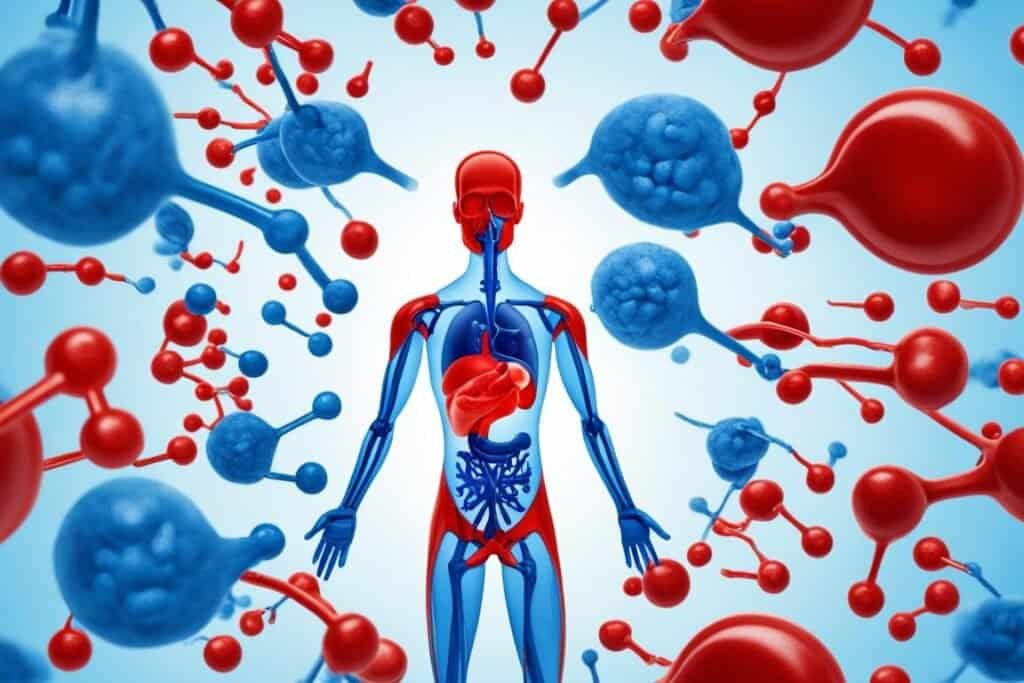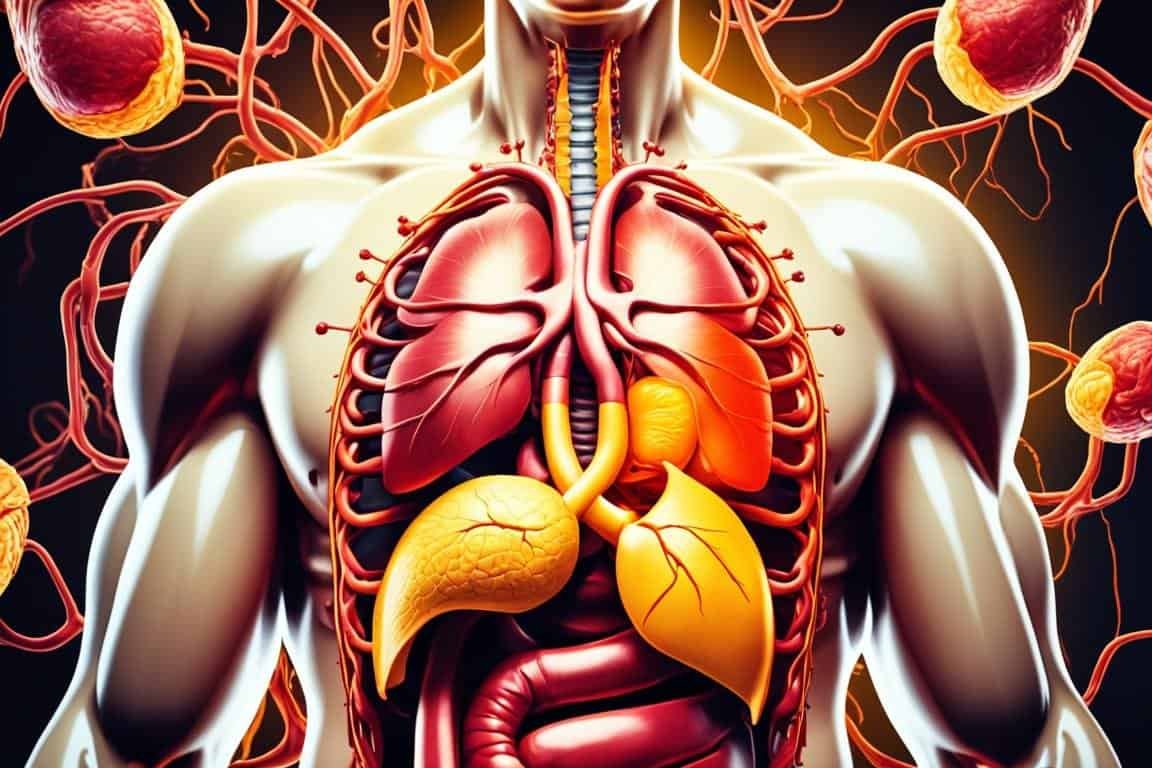If you have nephrotic syndrome, it’s important to understand the manifestation of hypertriglyceridemia and its impact on your health. Hypertriglyceridemia is a common occurrence in patients with nephrotic syndrome, characterized by elevated levels of triglycerides and other lipid abnormalities.
Lipoprotein(a) levels are often increased, while high-density lipoprotein cholesterol (HDL-C) levels may be normal or reduced, particularly the HDL2 fraction. This imbalance in lipid levels can have significant implications for your overall health and well-being.
Key Takeaways:
- Hypertriglyceridemia is commonly observed in patients with nephrotic syndrome and is characterized by elevated triglyceride levels.
- Patients with nephrotic syndrome may also experience abnormalities in other lipid markers, such as total cholesterol, LDL-C, and lipoprotein(a).
- Hypertriglyceridemia can increase the risk of complications, including cardiovascular disease and thromboembolic events.
- Effective management of hypertriglyceridemia in nephrotic syndrome involves a multifaceted approach, including lifestyle modifications and pharmacological interventions.
- Closely monitoring lipid levels and regular follow-up with healthcare providers are crucial for minimizing the risk of adverse outcomes.
Causes of Hypertriglyceridemia in Nephrotic Syndrome
The pathogenesis of hypertriglyceridemia in nephrotic syndrome involves abnormalities in lipid metabolism. Studies have shown that there is decreased catabolism of very low-density lipoproteins (VLDL), increased synthesis of LDL, and impaired chylomicron catabolism in patients with nephrotic syndrome. Proteinuria and hypoalbuminemia contribute to reduced lipoprotein catabolism. Furthermore, there is downregulation of lipoprotein lipase (LPL), VLDL receptor, and hepatic lipase in experimental nephrosis. These dysregulations in lipoprotein metabolism contribute to the high triglyceride levels observed in nephrotic syndrome patients.
To better understand the causes of hypertriglyceridemia in nephrotic syndrome, let’s take a closer look at the key factors:
- Decreased catabolism of very low-density lipoproteins (VLDL).
- Increased synthesis of LDL.
- Impaired chylomicron catabolism.
- Proteinuria and hypoalbuminemia leading to reduced lipoprotein catabolism.
- Downregulation of lipoprotein lipase (LPL), VLDL receptor, and hepatic lipase.
These abnormalities in lipid metabolism disrupt the balance of lipoprotein production and clearance, resulting in the accumulation of triglycerides in the bloodstream of nephrotic syndrome patients.
As the understanding of lipid abnormalities in nephrotic syndrome deepens, further research is still needed to uncover the complete mechanisms and develop targeted interventions for managing hypertriglyceridemia in this condition.
Complications of Hypertriglyceridemia in Nephrotic Syndrome
Hypertriglyceridemia in patients with nephrotic syndrome can lead to various complications. The elevated levels of triglycerides pose an increased risk of atherosclerosis, cardiovascular disease, and thromboembolic events. These complications can have serious consequences for your overall health and well-being.

Nephrotic syndrome-induced thromboembolism is a particular concern associated with hypertriglyceridemia. The combination of high triglyceride levels and the underlying kidney dysfunction can significantly increase the risk of developing blood clots that can obstruct blood flow to vital organs. It is crucial to be aware of this potential complication and take appropriate measures to minimize the risk.
Monitoring your lipid levels is vital in managing hypertriglyceridemia in nephrotic syndrome. Regular check-ups and close collaboration with your healthcare provider are essential in addressing and preventing these complications. Maintaining a healthy lifestyle and following prescribed treatment plans can help regulate lipid levels and reduce the risk of cardiovascular and thromboembolic events.
Managing Hypertriglyceridemia in Patients with Nephrotic Syndrome
Managing hypertriglyceridemia in patients with nephrotic syndrome requires a comprehensive approach that includes both lifestyle modifications and pharmacological interventions.
Lifestyle Modifications:
- Make dietary changes: Adopt a low-fat, low-cholesterol diet and limit the intake of foods high in saturated and trans fats. Include more fruits, vegetables, whole grains, and lean proteins in your meals.
- Incorporate regular exercise: Engage in moderate-intensity aerobic activities, such as walking, swimming, or cycling, for at least 150 minutes per week. Physical activity can help improve lipid profiles and overall cardiovascular health.
Pharmacological Interventions:
If lifestyle modifications alone are insufficient in managing hypertriglyceridemia, your healthcare provider may consider prescribing medications to help lower triglyceride levels and improve lipid metabolism.
- Statin Therapy: Statins are commonly used drugs that inhibit an enzyme involved in cholesterol synthesis, leading to a reduction in triglyceride levels. Your doctor will determine the appropriate statin and dosage based on your individual needs and medical history.
- Fibric Acid Derivatives: Fibric acid derivatives work by activating receptors involved in lipoprotein metabolism, resulting in decreased triglyceride levels. They may be prescribed alongside statins for patients with elevated triglycerides.
Regular monitoring of lipid levels is crucial for evaluating the effectiveness of the management plan. Your healthcare provider will schedule follow-up appointments to assess your progress and make any necessary adjustments to your treatment regimen.
| Treatment Options | Description |
|---|---|
| Lifestyle Modifications | Includes dietary changes and regular exercise to improve lipid profiles. |
| Statin Therapy | Prescription medications that help lower triglyceride levels by inhibiting an enzyme involved in cholesterol synthesis. |
| Fibric Acid Derivatives | Medications that activate receptors involved in lipoprotein metabolism, leading to decreased triglyceride levels. |
Implications of Hypertriglyceridemia on Health in Nephrotic Syndrome
Hypertriglyceridemia in individuals with nephrotic syndrome can have significant implications for their overall health and well-being. Elevated levels of triglycerides in the blood can contribute to increased cardiovascular risk and a higher incidence of thromboembolic events. These complications can have detrimental effects on both physical health and quality of life.
Managing hypertriglyceridemia is crucial for minimizing the risk of these adverse outcomes. This involves implementing lifestyle modifications, such as a healthy diet and regular exercise, to improve lipid profiles. Additionally, pharmacological interventions may be considered to reduce triglyceride levels and improve lipid metabolism.
By effectively managing hypertriglyceridemia, individuals with nephrotic syndrome can reduce their risk of cardiovascular complications and improve their overall health outcomes. Regular monitoring of lipid levels and close follow-up with healthcare providers are essential for optimizing management strategies.

| Implications of Hypertriglyceridemia in Nephrotic Syndrome | |
|---|---|
| Increased cardiovascular risk | In individuals with nephrotic syndrome, hypertriglyceridemia contributes to an increased risk of cardiovascular diseases such as heart attacks and strokes. |
| Higher incidence of thromboembolic events | Hypertriglyceridemia in nephrotic syndrome is associated with a greater likelihood of developing blood clots, which can lead to serious complications like pulmonary embolism or deep vein thrombosis. |
| Detrimental effects on overall health and quality of life | The complications arising from hypertriglyceridemia can have a significant negative impact on the overall health and well-being of individuals with nephrotic syndrome, affecting their daily activities and overall quality of life. |
Role of Cholesterol in Nephrotic Syndrome
Cholesterol plays a critical role in the pathogenesis and progression of nephrotic syndrome. It is involved in the dysregulation of lipid metabolism, leading to the manifestation of hypertriglyceridemia and other lipid abnormalities. The understanding of how cholesterol affects the disease process can provide insights into potential therapeutic targets and interventions.
Several studies have highlighted the significance of cholesterol in nephrotic syndrome. Research has shown that elevated cholesterol levels are associated with the development and severity of the condition. The dysregulation of lipid metabolism, influenced by cholesterol, contributes to the abnormal lipid profile observed in patients with nephrotic syndrome [1,2,3,4,5,6].
One of the key mechanisms by which cholesterol impacts nephrotic syndrome is through the dysregulation of lipoprotein metabolism. In patients with nephrotic syndrome, there is a decrease in the catabolism of very low-density lipoproteins (VLDL) and impaired chylomicron catabolism, leading to increased synthesis of low-density lipoproteins (LDL) and elevated triglyceride levels [3,4,5,6]. These alterations in lipoprotein metabolism further contribute to the development of hypertriglyceridemia.
The role of cholesterol in nephrotic syndrome extends beyond its impact on lipid metabolism. Studies have indicated that cholesterol is involved in the regulation of inflammatory processes in renal cells [7,8]. This inflammatory response plays a significant role in the progression and complications of nephrotic syndrome. Understanding the intricate interplay between cholesterol, lipid metabolism, and inflammation can help identify potential therapeutic targets and interventions aimed at managing and preventing the progression of nephrotic syndrome.
Further research is needed to unravel the complexities of cholesterol’s role in nephrotic syndrome fully. By exploring the mechanisms by which cholesterol contributes to the pathogenesis of the disease, researchers can identify novel approaches for intervention and improve patient outcomes.
Impact of Hypertriglyceridemia on Kidney Function in Nephrotic Syndrome
Hypertriglyceridemia in nephrotic syndrome can have a significant impact on kidney function. Studies have shown that dyslipidemia, including elevated levels of triglycerides, can contribute to renal damage and worsen the progression of kidney disease. This highlights the importance of understanding the link between lipid abnormalities and kidney health in patients with nephrotic syndrome.
One of the mechanisms through which hypertriglyceridemia affects kidney function is the altered expression of lipoprotein receptors in the kidneys. Decreased lipoprotein receptor expression can impair the clearance of lipoproteins and contribute to the accumulation of lipids in the renal cells, leading to renal damage.
In addition, abnormal lipid metabolism in the kidneys may play a role in the impact of hypertriglyceridemia on kidney function. Altered lipid metabolism can disrupt normal cellular processes and contribute to inflammation and oxidative stress, further exacerbating kidney damage.
To better understand the specific mechanisms underlying the impact of hypertriglyceridemia on kidney function in nephrotic syndrome, further research is needed. This research can provide valuable insights into potential targets for therapeutic interventions aimed at preserving kidney function and improving outcomes for patients with nephrotic syndrome.
Managing hypertriglyceridemia in nephrotic syndrome is crucial not only for minimizing cardiovascular complications but also for preserving kidney function. By addressing dyslipidemia and promoting overall lipid balance, healthcare providers can potentially slow down the progression of kidney disease and improve the long-term prognosis for patients.
Conclusion
In conclusion, hypertriglyceridemia is a common manifestation of nephrotic syndrome, characterized by elevated triglyceride levels and other lipid abnormalities. This dysregulation of lipid metabolism in nephrotic syndrome contributes to the development of hypertriglyceridemia and has implications for both overall health and kidney function. Effective management of hypertriglyceridemia is crucial in reducing the risk of cardiovascular complications and improving outcomes for patients with nephrotic syndrome.
Further research is needed to gain a better understanding of the underlying mechanisms of lipid abnormalities in nephrotic syndrome and to develop targeted interventions. By addressing the dysregulation of lipid metabolism, healthcare professionals can help patients achieve better lipid profiles and improve their overall health.
With the implementation of appropriate lifestyle modifications, such as dietary changes and regular exercise, as well as pharmacological interventions, including statin therapy and fibric acid derivatives, patients with nephrotic syndrome can actively manage their hypertriglyceridemia and reduce the risks associated with cardiovascular disease and thromboembolic events.

